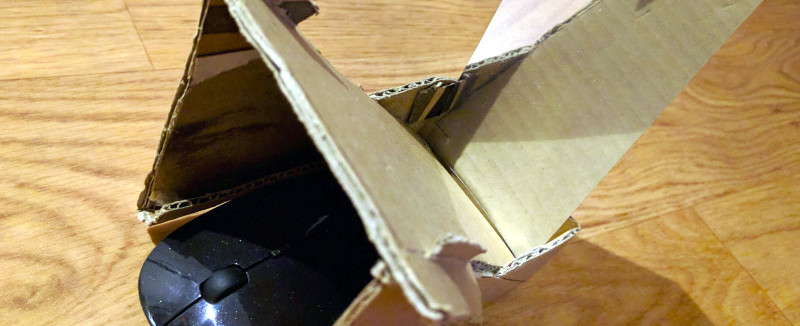Taking a dive into VR or augmented reality — once, dreamed-of science fiction — is not only possible for the average consumer, but crafting those experiences is as well! Hackaday.io user [kvtoet]’s HandHolo is a homebrew method to cut your teeth on peeking into a virtual world.
This project requires a smartphone running Android Oreo as its backbone, a Bluetooth mouse, a piece of cardboard and a small mirror or highly reflective surface. The phone is slotted into the cardboard housing — prototype with what you have! — above the mouse, and the mirror angled opposite the screen reflects the image back to the user as they explore the virtual scene.
Within Unity, [kvtoet]’s used a few scripts that access phone functions — namely the gyroscope, which is synchronised to the mouse’s movements. That movement is translated into exploration of the virtual space built in Unity and projected onto the portal-like mirror. Check it out!
It’s a straightforward setup process if you want to give it a whirl, and an excellent project to flex those aspirational game dev skills or dabble in augmented reality — something that is more and more popular these days.
















Cardboard. So, just start with mashed crap. Got it.
Faster and cheaper than a 3d print. Whats your problem?
Mashed crap. Show some pride?
he has a lot of pride which is why he showed it worked which is 10,000 times more important then how it looks. this truly is the don’t fall that has come from 3D printers, it doesn’t matter how impressive the project is because its all about looks now.
He solved the problem. This is a proof of concept not a prototype for a commercial project so KISS is a valid option. Show some respect for the hack instead of spreading bad mojo.
THAT.
I think it’s a little illogical the current trend (fad?) of “I need a small plastic square, let’s 3D print it”
That’s a brilliant idea! So simple and cool. I wonder how long until someone makes a 3D printed model to replace the cardboard?
Just waiting for DIY AR for the optic nerve. SCALPEL!
Not sure I understand why you need the mouse. Why not link it to the phones GPS, step counter, or accelerometer? Same for the mirror. What makes this more than just looking at the screen and moving around the environment or moving the phone around.
Also every time I see cardboard used in a project; I think garbage in the worst case, and recycling as the best case. At least he isn’t charging $70 for his cardboard garbage like Nintendo. So many options out there, what happened to good old wood.
In any case, none of this seems necessary because the phones screen and sensors could do this just as easy without a mirror and mouse. Not trying to be overly critical, just not getting it.
I think you overestimate the accuracy of GPS. Gyro’s can accurately measure rotation, but the accelerometers need to integrate twice in order to calculate position. This is very noise sensitive, the mouse gives absolute positioning with very high accuracy.
Well, Pokemon Go works, doesn’t it?
Why do all the people here hate cardboard ?!
Renewable AR.
Cardboard is just perfect for a quick proof-of-concept prototype. Once the design is improved and its kinks smoothed, cut sheet metal or PAI will do if one is building a one-off device and the design calls for flat pieces.
3D prints are still too expensive and/or unavailable for most of the world (and slow for everyone) to be practical for simple pieces.
1. HaD said: “Taking a dive into VR or augmented reality — once, dreamed-of science fiction — is not only possible for the average consumer, but crafting those experiences is as well!”
2. HaD said: “This project requires a smartphone running Android Oreo as its backbone…”
I DISAGREE HaD: The current “Average Consumer” will probably NEVER get an Android Oreo update on his/her phone – thanks to Google, and thanks to PLANNED OBSOLESCENCE by the phone manufacturers. Pure Evil lives-on the smart phone market.
anyone forget about Nintendo using cardboard for the new line of Switch gear? What about Google? Did you forgot about the cardboard project?
All junk right?